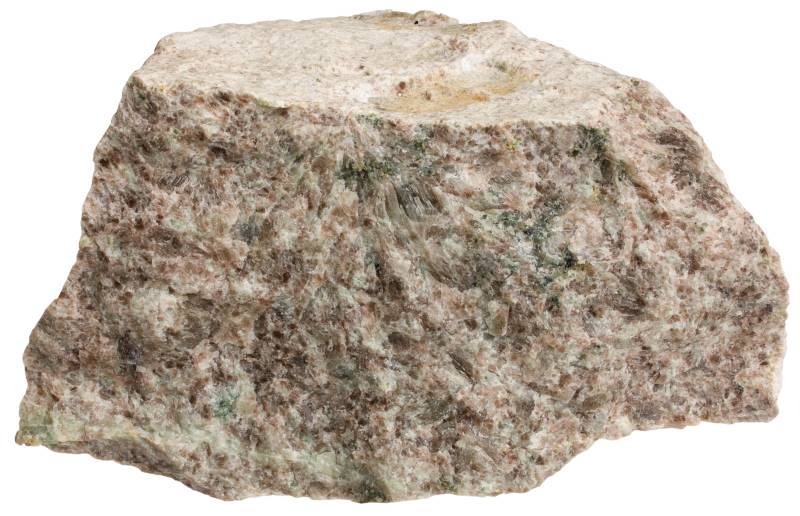Anorthosite is an igneous monomineralic rock that is composed of plagioclase feldspar (over 90% of the rock is composed of this mineral). Plagioclase is a very common mineral group, more than half of the Earth’s crust is composed of it. Therefore it isn’t really surprising that there is a rock type that is almost exclusively composed of plagioclase. Anorthosite is sometimes named plagioclasite or labradorite as well.

Anorthosite is usually light-colored because its main constituent plagioclase feldspar is normally white and most anorthosites have no iridescence. Rogaland, Norway. Width of sample 13 cm.
Because of linguistic similarities some people think that anorthosite is a rock composed of anorthite (one of plagioclase group minerals). This is not true. Anorthosite is usually composed of labradorite and sometimes bytownite or andesine as well (all plagioclase group minerals).

Anorthosite from Finland (known also as spectrolite) showing labradorescence (blue spot). The width of the rock sample is 17 cm.

Another sample of anorthosite from Rogaland, Norway. Width of sample 12 cm.
The term ‘labradorite’ itself is a source of confusion as well. Maybe not so much in the USA because this trap was set by French and Russian geologists and creates trouble where their influence for historical reasons have been greater. The problem is that labradorite for them is a rock type containing lots of mineral labradorite. So the problem is just like the famous dolomite problem. One always has to think about what are we actually talking about – a rock or a mineral?
Anorthosite is usually defined as a leucocratic rock. Leucocratic means light-colored? Well, this is complicated. It needs to be careful here as well. Leucocratic can be defined as ‘felsic’ or ‘not mafic’. Leucocratic minerals are those that are relatively rich in silicon and aluminum but contain little iron and magnesium. Felsic minerals (quartz, feldspar, muscovite) are generally lighter than mafic minerals (pyroxene, hornblende, biotite, olivine) but not always. Some plagioclase feldspars are definitely darker than bright green olivine crystals. And some pyroxenes are colorful as well. Nature does not care about our classification schemes and always finds a way to laugh at us. Anorthosite in many cases is not light-colored at all. This is the result of tiny Fe-Ti oxide inclusions in plagioclase crystals that give them bluish-black hue.
One fascinating aspect associated with many anorthosites is an effect called labradorescence. It is a special form of iridescence. Plagioclase crystal is composed of many exsolution lamellae — minerals have broken up into many slabs of alternating composition. These slabs act like mirrors. Some light reflects back from the crystal surface but some portion of it penetrates the surface to be reflected back from the next lamellae which is 20…50 nanometers below the surface. Reflected lightwaves combine (this is called interference) and create peculiar colors which in our case seem to be mostly blue.
If you want to see anorthosite, you don’t have to go far – just look up at the night sky. It is a common rock type on the Moon (take a look at the post of lunar anorthosite). The highlands of the Moon surrounding the dark basaltic lava fields called maria are composed of this rock type.

Anorthositic dike surrounded by metamorphic rocks. Hedmark, Norway.

Anorthositic landscape in Rogaland, Norway.
Anorthosite is not nearly as common here as it is on the Moon. Anorthosites on the Moon are extremely old, almost as old as the Moon itself. Anorthosites on Earth are pretty old too, mostly from the Proterozoic Eon. Anorthosite is a plutonic rock just as granite and gabbro and it is usually associated with the latter. Therefore we can conclude that despite being officially leucocratic it actually is usually associated with mafic rocks.
Anorthosite is usually considered to be a cumulate rock. These are magmatic rocks that have crystallized from the magma which is enriched in low- or high density minerals. Anorthosite should therefore represent the upper portion of certain magma chambers where light plagioclase crystals have accumulated. However, there are lots of still unsolved questions. For example: if it really is a cumulate rock then where are the opposite mafic cumulates that are composed of pyroxene and olivine? I don’t want to say that these rocks don’t exist. They do in some other areas. These interesting rocks are collectively called peridotites. Peridotite is a common constituent of the Earth’s mantle but usually not associated with anorthosites.
One more interesting aspect is that most plutonic igneous rocks have extrusive equivalents. These pairs are gabbro-basalt, granite-rhyolite, etc. But there is absolutely no volcanic equivalent of anorthosite. Why not? And why did these rocks mostly form in the middle of the Proterozoic Eon?
Anorthosite is not an uncommon rock. It is present in nearly every continental landmass (exceptions are Greenland and Australia1).
Update
It came as a nice surprise that this post inspired several other geobloggers to write about their experiences with this rock as well. Check out the blogs of Ron Schott, Garry Hayes, Dana Hunter, Ian G. Stimpson, Callan Bentley, Ryan Jackson, and Mika McKinnon who participated in this geomeme.
References
1. Best, Myron G. (2002). Igneous and Metamorphic Petrology![]() , 2nd Edition. Wiley-Blackwell.
, 2nd Edition. Wiley-Blackwell.
After reading in your post that anorthosite is mostly Proterozoic I was really hoping to find out why, that would be interesting. But alas, even by the end of the post it is still a mystery. I totally relate to your statement that Nature has no use for classification. It is often true in plant community ecology, and yet we still try to force Nature into categories … or rather my employers tell me I have to!
Due to an older computer and problems with browsers, it’s essentially impossible for me to blog anymore. But here are a couple of old posts I’ve done that are appropriate for the meme.
http://outsidetheinterzone.blogspot.com/2009/03/monday-mineral-labradorite.html
http://outsidetheinterzone.blogspot.com/2009/01/monday-mineral-sunstone.html
Lockwood, thanks for the links. I hope you get your blog going again!